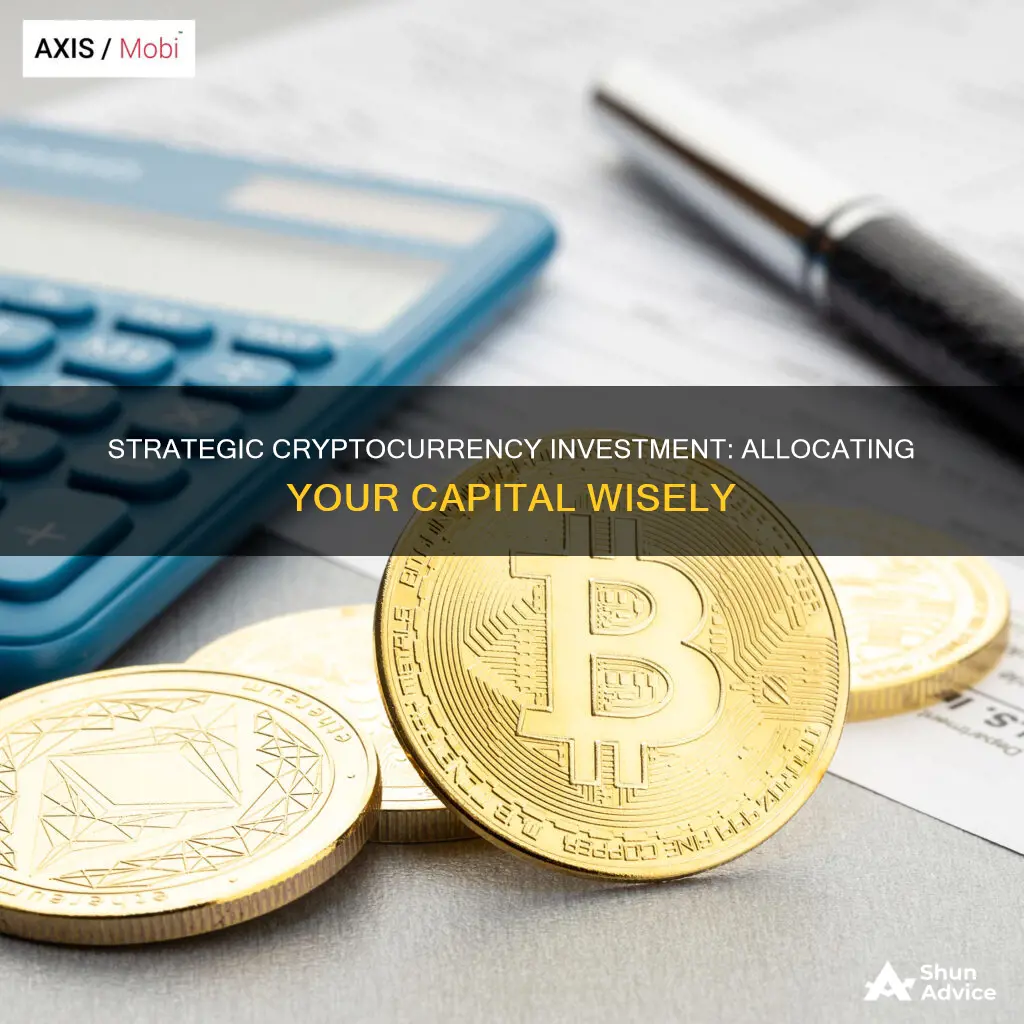
Investing in cryptocurrency can be a risky business, but it can also be a way to make a lot of money. The most well-known cryptocurrency, Bitcoin, has seen wild fluctuations in price over the years, and its success has led to the creation of thousands of alternatives, or altcoins.
If you're thinking about investing in cryptocurrency, it's important to understand the risks involved. The crypto market is very volatile, and there is a potential for high losses due to security breaches. Additionally, cryptocurrencies are not backed by governments or precious metals, so their value is solely based on people's perception of them.
When deciding how much to invest, it's crucial to consider your risk tolerance and how much money you can afford to lose. Some experts suggest investing around 5% to 30% of your investment capital in cryptocurrencies, while others recommend a much smaller amount, such as $100 per month. It's also important to diversify your investments and not put all your eggs in the crypto basket.
Remember, investing in cryptocurrency is speculative, and no one can accurately predict what will happen to the market. So, make sure you are well-informed about the risks and only invest what you can afford to lose.
| Characteristics | Values |
|---|---|
| Initial Investment | Less than $100 |
| Investment Horizon | Long-term |
| Risk Profile | High-risk |
| Investment Vehicle | Cryptocurrency Exchanges, Traditional Stockbrokers, Money Transfer Apps, Crypto ATMs, Crypto ETFs, Crypto Wallets |
| Investment Amount | $10-$25 minimum |
| Investment Frequency | Day trading, long-term |
| Investment Strategy | Buy-and-hold, trading |
| Investor Suitability | Not suitable for risk-averse investors |
What You'll Learn

How much to invest in crypto mining
Crypto mining is a complicated process that requires a lot of capital expenditure on technology equipment, electricity, and cooling equipment for the large number of computers used. The crypto mining business is risky, but it can be promising and profitable if bitcoin appreciates in the future.
The cost of investing in crypto mining varies depending on the type of operation you want to run. For example, a basic rig for some of the less popular cryptocurrencies can be put together for around $3,000, while some miners spend more than $10,000 on their rigs.
To be able to mine with some chance of success, you'll need to invest in one of the top graphics processing units (GPUs) or an application-specific integrated circuit (ASIC). Capable GPUs can range in price from about $1,000 to $2,000, while ASICs can cost much more, into the tens of thousands of dollars.
It's important to note that the difficulty of Bitcoin mining increases over time as the number of miners in the network grows to keep the Bitcoin supply consistent. This means that even with significant investment in equipment, smaller miners may struggle to compete with larger mining operations.
Another option for those interested in crypto mining is to join a mining pool, where miners combine their resources to increase their chances of earning rewards. However, this comes with a fee, reducing overall profits.
Overall, investing in crypto mining requires careful consideration of the potential risks and rewards, as well as a significant financial investment in equipment and ongoing costs such as electricity.
Bitcoin or Stocks: Where to Invest Your Money?
You may want to see also

How much to invest in crypto trading
Investing in cryptocurrency can be risky, but it can also be lucrative. The price of cryptocurrencies is extremely volatile, meaning their prices fluctuate a lot, which creates opportunities to profit.
There is no specific minimum amount of money required to begin crypto trading. Some platforms allow you to trade with as little as $1. However, most experts recommend starting with at least $250-$500. This gives enough cushion to absorb losses as you learn without wiping out your capital. For more sophisticated strategies, $2,000-$5,000 is recommended.
Your starting capital will depend on factors like your goals, trading style, and risk tolerance. It should be noted that the more capital you have, the more coins you can invest in while properly diversifying. It is recommended to have at least $1,000 to spread your investment over 5–10 assets to reduce risk instead of just 1 or 2 volatile coins. Day traders, who open and close positions within a single day, require even more starting capital, typically around $5,000. This allows for enough trading activity within volatile daily price swings while accounting for transaction costs.
Long-term investors can start with much less. It is advised to never invest more than you can afford to lose. Some experts recommend investing no more than 1% to 5% of your net worth. When deciding how much to invest, limiting your overall exposure to crypto is crucial.
Additionally, it is important to consider the fees associated with crypto trading. Exchanges like Coinbase charge fees when you buy, sell, or withdraw cryptocurrency, which can range from 0.5% to 1% per trade. The spread, or the difference between the buy and sell prices quoted for a crypto pair, can also impact the cost of trading.
Before investing in cryptocurrency, it is essential to do your research and carefully evaluate the risks. Cryptocurrencies are high-risk assets, and there is the potential to lose some or even all of your investment. It is crucial to only invest what you can afford to lose and to have an emergency fund and a manageable level of debt before considering crypto investments.
Creating a Fake Bitcoin Investment Website: A Step-by-Step Guide
You may want to see also

How much to invest in altcoins
Determining how much to invest in altcoins depends on several factors, including your risk tolerance, investment goals, and financial situation. Here are some key considerations to help you decide:
Understanding Altcoins
Firstly, it's important to understand what altcoins are. Altcoins are any cryptocurrencies other than Bitcoin (and sometimes Ethereum). They are created to improve upon Bitcoin's functionality or address its perceived limitations. There are thousands of altcoins available, each with its own unique features and purpose.
Risk Assessment
Altcoins are generally considered riskier investments than Bitcoin. They often have smaller market capitalizations, less liquidity, and higher volatility. Before investing, carefully consider your risk tolerance and ensure you understand the specific risks associated with altcoins, such as the potential for fraud or market manipulation.
Diversification
Diversifying your cryptocurrency portfolio by investing in multiple altcoins can help spread risk. However, it's crucial to conduct thorough research on each project before investing. Assess the whitepaper, the team behind the coin, its use cases, and the problem it aims to solve. Diversification can also be achieved by investing in a mix of more established altcoins and newer, potentially higher-growth coins.
Investment Amount
The amount you invest in altcoins should be based on your overall investment budget and how much risk you are comfortable with. It's generally recommended not to invest more than you can afford to lose. Start by allocating a small portion of your investment funds to altcoins and gradually increase your allocation as you gain more knowledge and confidence in the market.
Dollar-Cost Averaging
Consider using a dollar-cost averaging strategy when investing in altcoins. This involves investing a fixed amount at regular intervals, such as weekly or monthly. This approach can help smooth out the impact of market volatility and reduce the risk of investing a large sum at an inopportune time.
Long-Term Investment Horizon
Investing in altcoins typically requires a long-term investment horizon. The cryptocurrency market, especially altcoins, can be highly volatile, with significant price fluctuations. By adopting a long-term perspective, you can focus on the potential for growth over several years rather than being concerned with short-term price movements.
In conclusion, determining how much to invest in altcoins depends on your individual circumstances and risk appetite. Conduct thorough research, diversify your holdings, and consider starting with small investments, gradually increasing your allocation as you gain experience in the market. Remember that investing in altcoins carries significant risks, and you should never invest more money than you are comfortable losing.
Elon Musk's Dogecoin Investment: How Much Money?
You may want to see also

How much to invest in stablecoins
Stablecoins are a type of cryptocurrency that is designed to maintain a fixed value over time. They are less volatile than other cryptocurrencies, making them more useful as a medium of exchange. Stablecoins are often pegged to a specific currency, such as the US dollar, or to the price of a commodity, such as gold.
When deciding how much to invest in stablecoins, it is important to consider the risks involved. While stablecoins are less volatile than other cryptocurrencies, they are still subject to risk. One key risk is counterparty risk, which involves trusting that the third-party entity managing the stablecoin can maintain their supply of dollars equal to the supply of stablecoins. Another risk to consider is reserve risk, which involves the possibility that the reserves backing a stablecoin may not be sufficient to guarantee its value. Additionally, stablecoins may be subject to regulatory changes, which could affect their value.
When determining how much to invest, it is important to consider your investment goals and risk tolerance. Stablecoins may be a good option for those who want to own cryptocurrency but are hesitant about its extreme volatility. They can also be used for quick and cheap payments or money transfers on a global scale. However, it is important to note that stablecoins are not designed for explosive gains, and their prices generally do not fluctuate much.
To invest in stablecoins, you will need to open an account with a crypto exchange or use a digital wallet to buy crypto directly. Some popular stablecoins include Tether, USD Coin, and Dai. It is always recommended to do your own research and consult with a financial advisor before making any investment decisions.
The Wild Ride of Investing in Bitcoin
You may want to see also

How much to invest in NFTs
Non-fungible tokens (NFTs) are digital assets that represent ownership of other assets, usually digital art, music, videos, or in-game items. NFTs are unique, and therefore non-fungible, because they are connected to cryptocurrencies and are tokens on a blockchain.
The amount you should invest in NFTs depends on a variety of factors. Firstly, it depends on the type of NFT you are interested in. NFTs can represent digital or real-world assets, and the value of the NFT is tied to the value of the underlying asset. NFTs representing digital-only items may not have growth potential or sustainable value unless there is consistent demand from collectors.
Secondly, it depends on your risk appetite and investment goals. NFTs are a risky and speculative investment, and the market is largely unregulated, making it susceptible to volatility, fraud, and scams. If you are generally risk-averse, the potential for higher returns may not be enough to lure you into investing in NFTs.
Thirdly, you should consider the fees involved in buying and selling NFTs. These include gas fees, which are the amount of money paid to carry out the transaction, as well as listing fees and conversion fees for converting your dollars to cryptocurrency.
Finally, you should do your research and due diligence before investing in any NFT project. Not all NFT projects are created equal, and some may not guarantee the rights to the underlying digital asset. It is important to thoroughly research a potential purchase and the reputation of the original NFT seller to ensure that you know what you are buying and to avoid scams and fraudulent activities.
In conclusion, the amount you should invest in NFTs depends on your individual circumstances and investment goals. It is important to carefully consider the risks and potential rewards before making any investment decisions.
Bitcoin Investment: Is It Worth the Risk?
You may want to see also







